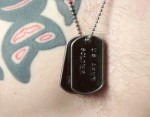Apr 29, 2009
Emotional Cartography
Via Info Aesthetic

The free-downloadable book Emotional Cartography - Technologies of the Self is a collection of essays that explores the political, social and cultural implications of visualizing intimate biometric data and emotional experiences using technology. The theme of this collection of essays is to investigate the apparent desire for technologies to map emotion, using a variety of different approaches.
18:11 Posted in Emotional computing, Information visualization | Permalink | Comments (0) | Tags: information visualization, affective computing
Nov 04, 2007
Beat wartime empathy device
Via Pasta & Vinegar

Designer Dominic Muren has created a device that allows a civilian to feel the heartbeat of a soldier:
I think we can all agree that war has become too impersonal. Media coverage emphasizes our distance, and most decision makers in congress don't have children who fight. Beat connects you very directly to a single soldier by thumping their recorded heartbeat against your chest. If they are calm, or worried, or under stress, you feel it. If they die, the heartbeat you feel dies too. If we are going to continue to fight wars, we need better methods of feedback like this one so the costs are more visceral and real for us. Imagine if all politicians were required to wear one of these!!
19:25 Posted in Emotional computing | Permalink | Comments (0) | Tags: affective computing
Jun 07, 2007
Kansei robot
Via Pink Tentacle

Researchers at Meiji University have developed a robot face called "Kansei" that is capable of a wide range of emotional expressions. The robot is part of a program that aims at creating conscious and self-aware robots.
23:42 Posted in AI & robotics | Permalink | Comments (0) | Tags: affective computing
Oct 04, 2006
Affective communication in the metaverse
Via IEET
Have a look at this thought-provoking article by Russel Blackford on affective communication in mediated environments:
One of the main conclusions I’ve been coming to in my research on the moral issues surrounding emerging technologies is the danger that they will be used in ways that undermine affective communication between human beings - something on which our ability to bond into societies and show moment-by-moment sympathy for each other depends. Anthropological and neurological studies have increasingly confirmed that human beings have a repertoire of communication by facial expression, voice tone, and body language that is largely cross-cultural, and which surely evolved as we evolved as social animals.
The importance of this affective repertoire can be seen in the frequent complaints in internet forums that, “I misunderstood because I couldn’t hear your tone of voice or see the expression on your face.” The internet has evolved emoticons as a partial solution to the problem, but flame wars still break out over observations that would lead to nothing like such violent verbal responses if those involved were discussing the same matters face to face, or even on the telephone. I almost never encounter truly angry exchanges in real life, though I may be a bit sheltered, or course, but I see them on the internet all the time. Partly, it seems to be that people genuinely misunderstand where others are coming from with the restricted affective cues available. Partly, however, it seems that people are more prepared to lash out hurtfully in circumstances where they are not held in check by the angry or shocked looks and the raised voices they would encounter if they acted in the same way in real life.
This is one reason to be sightly wary of the internet. It’s not a reason to ban the internet, which produces all sorts of extraordinary utilitarian benefits. Indeed, even the internet’s constraint on affective communication may have advantages - it may free up shy people to say things that they would be too afraid to say in real life.
Read the full article
22:30 Posted in Future interfaces | Permalink | Comments (0) | Tags: affective computing
Sep 30, 2006
Beyond emoticons
Anthony Boucouvalas and colleagues at Bournemouth University in the UK have created a system that contorts an image of a user's face to express different emotions, New Scientist reports. According to Boucouvalas and coll., the system might be used to enrich text-based internet chat.
From the article:
A user first uploads a picture of their face with a "neutral" expression. Then they use their mouse to mark the ends of their eyebrows, the corners of their mouth and the edges of their eyes and lips. The software uses these points to morph the face to express different emotions: happiness, sadness, fear, anger, surprise, and disgust. A user can select an emotion and one of three intensity levels when using the system.
Read the full story here
See also Illustrations from Smiley Arena
19:05 Posted in Emotional computing | Permalink | Comments (0) | Tags: affective computing






